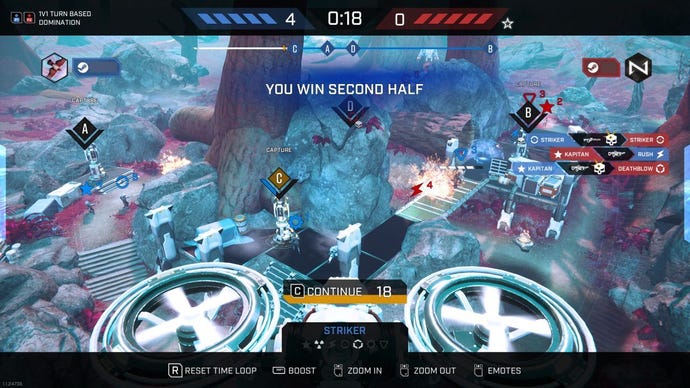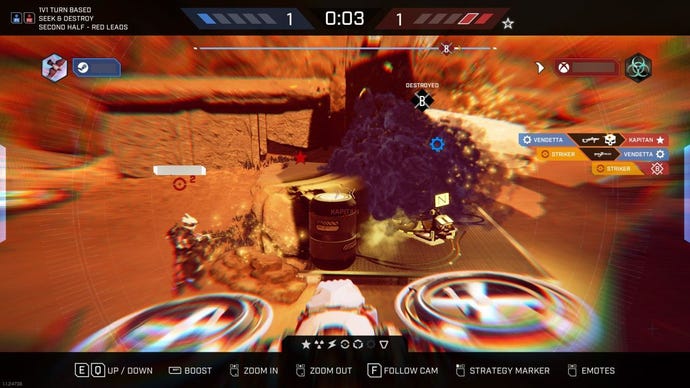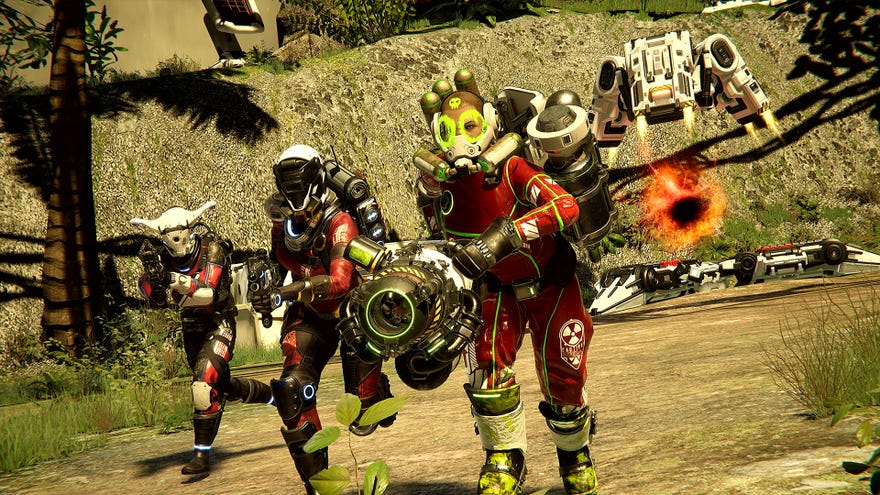Lemnis Gate review: a time-twisting shooter full of more frustration than creativity
This time ‘aint big enough for the both of us
Right. Let’s think about this. If I start the round by protecting my engineer with Karl’s shield, then he won’t be blown to pieces by Deathblow’s rocket at the six second mark. That means this loop he’ll survive to place the turrets I prepared in the first round, which should be enough to deal with the flanking zippy boy from round two. Then I can wrap around, finish off the Deathblow before he turns his rocket spam on the second objective, place a second shield on MY flanking zippy boy just in case he runs into trouble next loop, then finally fire some lasers at the first objective to counterbalance any extra enemy damage it might take in either the future or the past. Easy!
It’s not, but then again, it sort of is? Lemnis Gate clearly wants me to compare it to 4D Chess, but in (this) reality it feels much closer to timey-wimey Tic-Tac-Toe.
You’ve probably got two questions. One: why are we fighting across time? I do not know, and Lemnis Gate has not made any particular effort to tell me. Someone does mention the words ‘Lemnis Gate’ in the admirably brief tutorial using a tone that denotes terrible importance, but it really doesn’t matter. This isn’t about lore, it’s about high-octane yet cerebral temporal squabbling between seven mechanically distinct yet aesthetically beige characters, with the one questionable exception of the robot who looks and sounds almost exactly like Pathfinder from Apex Legends. Let’s not think about that, and move on to your second question: how are we fighting across time?
None of this is as overwhelming as it’s going to sound, trust me, but there are six different game modes and four separate objective types that could appear in any one of them. Every match revolves around sequentially inserting operatives into a 25 second loop (please trust me) across a series of rounds where each player can only choose each operative once. Once you move on to the next round, your past self runs around doing all the things you just did - unless they’re exploded by another operative from a later round, which they will be because they’re helpless and predictable. Mercifully, you also get a drone that lets you track everything that’s going on, alongside enough time between insertions to fly it around and figure out a plan.

Exactly what you’re doing will depend on which objectives you wind up with - annoyingly, you don’t get to choose which type to queue for. You’ll win be either defending or destroying generators, capturing flags and returning them to your base, charging up ‘accelerators’ by shooting them more than your enemy can, or, if you’ve landed in a deathmatch game, simply doing the most murders.
We’re nearly done, promise, but I’ve got to mention the game modes because they all play so differently. There’s a 1v1 mode where you and your opponent take it in turns to add an operative into the loop, a 1v1 mode where you simultaneously add operators to the loop, then the 2v2 equivalents of both of those with further variations on exactly who gets to play and when.
"You might be salivating at the prospect of rich mental back and forths, novel ideas and ingenious surprises... I was salivating too, but that is not the version of Lemnis Gate I have played."
Now, you might be thinking all of that adds up to some mighty fearsome boffin-offs. You might be picturing two wizened old time-wizards, twiddling their comically-proportioned beards as they muster all their powers of prediction and strategy, leaving white-hot reflexes to the kids. You might even be salivating at the prospect of rich mental back and forths, novel ideas and ingenious surprises, with layers of bluff and counterbluff stacked higher than a Delorean. I was salivating too, but that is not the version of Lemnis Gate I have played. Maybe those wizards exist and are like, properly going at it in the upper echelons of the skill curve, but nearly all of the matches in my bracket pan out in the same surprisingly simple fashion.
It’s the sniper’s fault, mostly. They alone have the power to delete opponents from across the map at the very start of a round, which is by far the most important time to kill someone. They have an ability that slows down time, too, which means they can usually kill nearly every other operator in the game. For a while, I thought no strategy could possibly beat saving them for the final round - in my “simultaneous” games, every match seemed to turn on who sniped best at the last. I was wrong, but not by much. A (so far at least) unbeatable strategy I’ve found is to play the sniper in the penultimate round, then spend the finale babysitting them as Karl the robo-shielder. The only times I’ve lost while doing that have either been thanks to me slightly misplacing the shield, or my enemy adopting the same tactic.

If that happens, then simultaneous games go the way of a bog-standard shootout, while turn-based usually seems to favour whoever goes last. That stings, even though every match is actually played across two separate loops and you swap at half-time. If you win the same number of objectives then the overall winner is whoever eked ahead on kills, which rarely fails to feel anticlimactic.
It does have its moments. There are neat interactions between operatives, like the way the rocket man’s rockets can backfire if they hit a shield on a close up enemy, or how the teleporting poison-spewer can toxify places where you know enemies are going to stand later on in a loop. Despite those, though, I can’t point to a single time when either me or my opponents have done something that’s made me go ‘ooh, that was clever’. When a plan falls apart, it’s usually down to a failure of execution rather than imagination: that shield is a particular culprit, with its habit of attaching to the ground rather than forming a bubble around an operative. The reply to every play is usually straight-forward, with both players going back and forth, undoing and redoing progress until the final round renders most of that irrelevant. That example I gave at the start was illustrative, but only of the games I played before I realised the importance of saving Karl for the end. Now I feel rail-roaded into repeating that effective strategy, rather than adapting a new one to each circumstance.
Because of that, Lemnis Gate lacks any background excitement, that required hum of tension or stress. The turn-based modes necessarily involve a lot of downtime, and even when it’s your turn to pop into the loop, shooting at people from the past can feel more like a chore than a challenge. Messing up in that context is a frustration, a failure to consistently clear a low bar rather than a satisfying defeat at the hands of someone who’s clearly outsmarted you. The simultaneous modes, meanwhile, play too much like straight-up shooters - shooters that inevitably pale in comparison to the likes of Overwatch.

It’s worth mentioning I haven’t had quite as long as I’d have liked to get to grips with higher-level play, because another unpleasantly recurring (wahey) thing about Lemnis Gate is its crashing habit. I’ve had my fair share of disconnects, too, as well as a great deal of difficulty trying to play with a friend - first having to re-download so we had the same Steam/Windows version, then trying to wrestle it into letting us form a party. I’ve consequently wound up in more 1v1s than 2v2s, and so I can’t rule out there being more depth tucked away there. At the very least, I’m sure it'll take some getting at.
I’ll close by pointing out this is an idea we’ve seen before, most recently with Quantum League, which Nic Reuben gave a favourable review but I wasn’t hot on thanks to its repetition and mediocre gunfeel. I will say Lemnis Gate is better on both counts by quite some margin, so if you got a kick out of Quantum League then hey, dig in. Fill your chrono-boots. Timey-wimey Tic Tac Toe is still an intriguing concept, and Game Pass provides a handy way to check out games that are more interesting than fun. It’s just a shame it hasn’t made me think harder about where to place my chrono-Xs.












